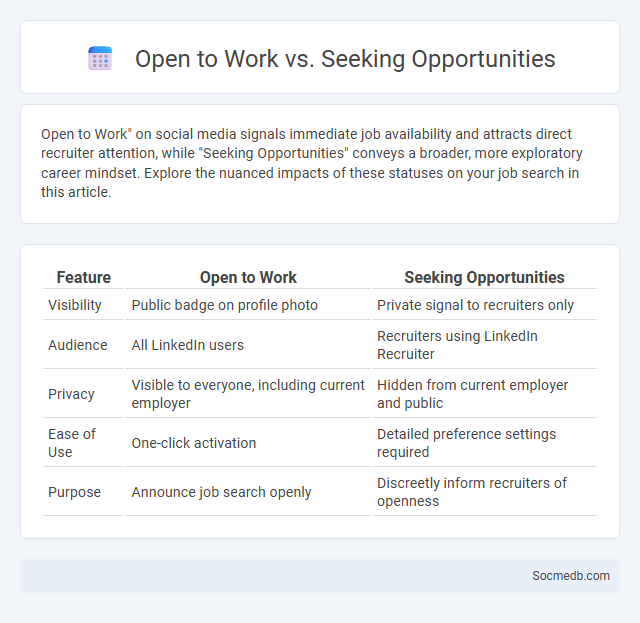
Photo illustration: Open to Work vs Seeking Opportunities
Open to Work" on social media signals immediate job availability and attracts direct recruiter attention, while "Seeking Opportunities" conveys a broader, more exploratory career mindset. Explore the nuanced impacts of these statuses on your job search in this article.
Table of Comparison
| Feature | Open to Work | Seeking Opportunities |
|---|---|---|
| Visibility | Public badge on profile photo | Private signal to recruiters only |
| Audience | All LinkedIn users | Recruiters using LinkedIn Recruiter |
| Privacy | Visible to everyone, including current employer | Hidden from current employer and public |
| Ease of Use | One-click activation | Detailed preference settings required |
| Purpose | Announce job search openly | Discreetly inform recruiters of openness |
Understanding "Open to Work," "Seeking Opportunities," and the Job Seeking Badge
Understanding the "Open to Work," "Seeking Opportunities," and Job Seeking Badge on social media platforms like LinkedIn can significantly enhance Your job search visibility to recruiters and hiring managers. These features allow You to signal Your readiness for new roles, tailor Your profile settings for privacy preferences, and highlight Your active employment status, boosting engagement with relevant job postings. Optimizing Your use of these tools increases the likelihood of receiving personalized job recommendations and direct outreach from potential employers.
Key Differences Between "Open to Work" and "Seeking Opportunities
The "Open to Work" feature on LinkedIn signals your current openness to new job opportunities directly on your profile, making it visible to recruiters and connections. In contrast, "Seeking Opportunities" is typically a more discreet status, often used in private job searches or less formal contexts without publicly broadcasting your availability. Understanding these differences helps you tailor your job search strategy effectively, ensuring your profile visibility matches Your desired level of openness.
Visibility Settings: Who Sees Your Job Searching Status?
Visibility settings on social media platforms control who can see your job searching status, allowing you to manage your professional image and privacy. LinkedIn, for example, offers options to share your job seeking activity with recruiters, your network, or keep it private, preventing current employers from noticing. Optimizing these settings enhances your job search effectiveness while maintaining discretion and controlling audience reach.
Impact of Badges on LinkedIn Profile Performance
Badges on LinkedIn profiles significantly enhance visibility and credibility, attracting more views and connection requests from relevant professionals. Your profile's engagement rates can increase by up to 30% when badges highlight certifications, skills, or accomplishments, boosting your chances for job opportunities and networking. Displaying these badges strategically strengthens your personal brand and reinforces expertise within your industry.
Pros and Cons of the "Open to Work" Banner
The "Open to Work" banner on social media platforms like LinkedIn enhances your visibility to recruiters, increasing job opportunities by signaling your availability directly on your profile photo. However, it may inadvertently limit your current employer's perception of your loyalty or invite unsolicited messages from recruiters, which can be overwhelming. Balancing the banner's benefits with potential drawbacks helps you maintain professionalism while actively pursuing new career prospects.
When to Use the "Seeking Opportunities" Feature
The "Seeking Opportunities" feature on social media platforms is most effective when actively looking for new job openings, networking possibilities, or freelance projects. Activating this setting signals recruiters and industry professionals about your availability, increasing the chances of relevant invitations and offers. For maximum visibility, use it during career transitions, after acquiring new skills, or when exploring different professional fields.
How Recruiters Perceive Job Seeking Indicators
Recruiters increasingly analyze social media profiles to identify job seeking signals such as updated job titles, public endorsements, and active participation in relevant industry groups. They interpret frequent engagement with job-related content, including sharing articles or commenting on industry trends, as subtle indicators that You are open to new opportunities. Optimizing Your social media presence to highlight professional achievements and network strategically can significantly influence recruiters' perceptions and improve your chances of being contacted for potential roles.
Privacy Concerns with Job Search Badges
Job search badges on social media platforms often share personal employment details that can expose users to privacy risks, including unauthorized access by recruiters or third parties. These badges may reveal sensitive information such as current employment status, job-seeking intentions, or professional skills, increasing vulnerability to profiling or identity theft. Users should carefully manage privacy settings to control visibility and ensure their job search activities remain confidential from unintended audiences.
Optimizing Your LinkedIn Profile with Job Seeking Features
Optimizing your LinkedIn profile with job-seeking features enhances your visibility to recruiters and hiring managers. Utilize LinkedIn's Open to Work feature, customize your headline with relevant keywords, and showcase your skills and endorsements. These strategic updates help your profile stand out in search results, increasing your chances of landing your desired job.
Choosing the Right Job Search Approach for Your Career Goals
Selecting the right job search approach on social media hinges on aligning platform strengths with specific career goals, such as leveraging LinkedIn for professional networking and industry insights or Instagram for creative portfolios. Tailoring content and engagement strategies to highlight skills and achievements relevant to target roles enhances visibility among recruiters and hiring managers. Consistent, strategic interaction on chosen platforms maximizes opportunities and accelerates career advancement.
 socmedb.com
socmedb.com